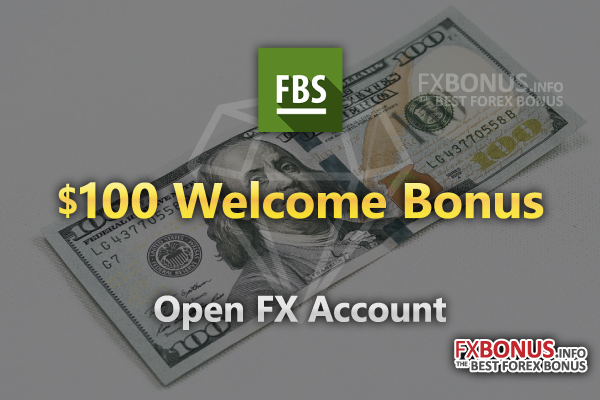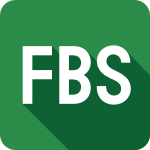Get FBS's $100 Bonus for free. Table of Contents

Start your online Forex trading for free
Do you want to start trading Forex online but afraid to lose your money or don’t know how to get started?
FBS welcomes such traders by giving away $100 No Deposit Bonus.
How does the promotion work?
By opening FBS’s “Trade 100 Bonus”, you will receive 100 USD for free in your real trading account to start trading Forex.

The bonus is given to new traders of FBS for free, and you do not need to make a deposit at all.
It is an ultimate risk-free bonus promotion to start trading Forex online, and is recommended for any types of traders who are new to the Forex market.
Want to see how it is to trade Forex online with the real money?
Then open FBS’s “Trade 100 Bonus” account today.
FBS’s $100 No Deposit Bonus promotion is only one of many promotions available with FBS.
For the list of FBS’s all bonus promotions, go to the page here.
Why you should try Forex trading with FBS?
In recent years, the asset management of investing in foreign currencies such as the US dollar and the euro, so-called foreign currency investment, has attracted attention.
In particular, “Forex Margin Trading (FX)” is gaining popularity among those who want to actively pursue profits by making use of exchange rate movements such as USD appreciation and USD depreciation.
“Foreign currency deposits,” which hold foreign currencies as deposits, are popular as foreign currency investments, but foreign exchange margin trading (FX) has the following two features that are significantly different from foreign currency deposits.
1. FBS offers up to 1:3000 high leverage
You can trade large amount due to the leverage effect.
For example, if you have 500 USD in cash, you can only buy foreign currency equivalent to 500 USD in foreign currency deposits, but if you are a foreign exchange margin trading (FX) of FBS, 500 USD is considered as “margin”.
By depositing 500 USD, you can trade foreign currency equivalent to 1,500,000 USD, which is up to 3000 times this amount.
Performing a large amount of transaction based on such a small amount of margin is called the “leverage effect” in the analogy of a lever.
You can use the leverage to trade 300,000 USD with margin of 100 USD.
With FX of FBS, you can trade up to 3000 times the maximum leverage, but as the leverage increases, you can expect a large return, but the loss when the exchange rate moves contrary to your expectations will also increase.
2. Make profits from both rising and falling prices
In the case of foreign currency deposits, if you start depositing US dollars, you will get profit (exchange gain) from price movements of the rising exchange rate.
Only when the USD strengthens and your currency weakens.
If the US dollar depreciates and your currency strengthens on the contrary, exchange loss will occur.
On the other hand, in foreign exchange margin trading (FX), you can start trading not only by “buying foreign currencies” but also by “selling foreign currencies”, and both have profit opportunities.
- Transactions that start with buying = The price of the bought currency goes up, and the higher you sell, the more profit
- Transactions that start from selling = The price of what sold currency decreases, and if you buy it back at the lower price you will get a profit
Starting a transaction by buying a foreign currency is often called a “long”, and starting a transaction by selling a foreign currency is called a “short”.
The currency that will be held as a result of a new transaction is called “Open Position” (or “position”).
How Forex trading works and the processes
Before starting foreign exchange margin trading (FX), let’s first imagine the specific flow of transactions.
Below, we will guide you step by step.
1. Open a Forex trading account
In order to use the foreign exchange margin trading (FX) of FBS, you must first open an account of FBS, then log in to FBS Official Website and also the trading platform.
In case of FBS’s $100 No Deposit Bonus, you may open “Trade 100 Bonus” account which already has 100 USD bonus in it.
The account opening process may only take a few minutes to complete.
Open FBS’s Real Trading Account
2. Make a deposit
After opening an account, you need to Deposit Margin into Forex Margin Trading Account.
Margin deposits into your Forex Margin Trading Account from your bank account or credit debit cards.
You can also use online wallets (e-wallets) to make a deposit to FBS’s live trading account.
The funds transferred from you will be converted into your account currency if the deposited currency is different from the account base currency.
Since there is no fee for transferring funds, it will be reflected immediately when you operate the screen.
3. Analyse the market trends
Daily information gathering is essential for making investment decisions.
It’s a good idea to keep a habit of regularly checking news that affects the exchange rate, such as economic trends, finances, geopolitical risks, foreign currency intervention, and interest rate differentials in each country.
FBS provides “Market News” with a timely exchange-related information.
You may use it together with the economic index calendar to collect information efficiently.
It is also very effective to refer to actual past price movements in order to predict future exchange rate movements.
4. Place an order
Once you fully understand the rules and risks of Forex Margin Trading (FX), collect information and decide your investment policy, you can start trading.
First, place a new order to hold an open position.
FBS offers a variety of ordering types that you can freely select according to your investment strategy.
After you place an order, make sure to confirm on the transaction history screen, etc. whether or not the order has been completed.
For example, in the case of a transaction that bought US dollars, you are in a position of holding open positions for buying US dollars (sometimes you may say “hold a position”).
The exchange rate changes from moment to moment, and profits and losses also occur in the open interest that we hold.
In foreign exchange margin trading (FX), in addition to gains and losses on exchange rates caused by exchange rate movements, there is also a “swap point” that is generated daily due to interest rate differences between two currencies.
Generally, if you start trading by selling high interest rate currencies (short), the swap points will be deducted from the margin day by day.
While you are holding open interest, be sure to check fluctuations in exchange rates and swap points, as well as the status of your open interest and the margin status.
6. Close the order
The open position that you have is closed by performing the opposite trade called “settlement”, then the transaction ends.
In addition to the foreign exchange gains and losses due to exchange rate movements, there will also be gains and losses due to the receipt and payment of the “swap points” mentioned above.
By the way, it is ideal to settle when the USD starts to depreciate if the transaction starts from buying foreign currency (long), and to settle when the USD appreciates if the transaction starts to sell foreign currency (short).
Conversely, the exchange rate may fluctuate.
It is also important to decide in advance how much loss you can tolerate in case a loss has occurred in the open interest, and to settle the loss early in order to prevent further loss expansion.
Swap Points for overnight carried positions
In foreign exchange margin trading (FX), in addition to the gains and losses caused by fluctuations in exchange rates, there are also gains and losses due to “swap points” that occur daily.
Swap points are a kind of interest rate that arises from holding open positions, but unlike interest rates in foreign currency deposits, there are times when the trader may receive it, while there are also cases where the trader has to pay it.
What is a swap point?
Consider a case where a customer sells EUR and buys US dollars (holds open interest in the US dollar/Euro pair) in foreign exchange margin trading (FX).
Since this is a state where you “borrowed EUR” and “purchased US dollars” based on the margin money, you need to pay the interest rate of the borrowed EUR, but you have the right to receive the interest rate of the bought US dollar ..
Swap points are adjusted for the interest rate difference between these two currencies.
If the US dollar interest rate is higher than the EUR interest rate, the interest rate that should be received is higher, so the customer will receive swap points.
Since interest rates vary from country to country, swap points, which are interest rate differences between two currencies, also differ depending on the combination of currencies to be exchanged.
Since swap points are given not to the amount of margin, but to the amount (position) with which you are trading If your position is $10,000 USD, you will get swap points for $10,000 USD.
Cases of receiving and paying swap points
In the previous example, it was received by the trader, but on the other hand, swap points also occur when the trader has to pay.
Whether the swap points are received or paid depends on the interest rate difference between the currency pairs, depends on the currency pair you trade.
If you start a transaction by buying a high-interest currency (long for a high-interest currency), you will receive it, while if you start a transaction for selling a high-interest currency (for a short high-interest currency), you will have to pay a payment.
FBS provides a number of different trading account types.
Visit the page here to see the list and comparison of FBS’s all trading account types today.
Please check FBS official website or contact the customer support with regard to the latest information and more accurate details.
FBS official website is here.
Please click "Introduction of FBS", if you want to know the details and the company information of FBS.


 IronFX
IronFX


Comment by Diletta
March 26, 2024
Awesome bonuses, good leverage. A few hiccups, but support rocks!